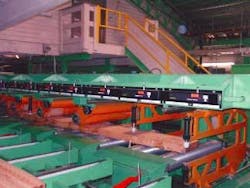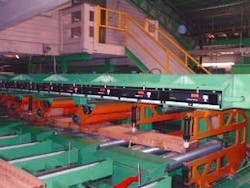Machine vision must reduce the total cost of ownership
A discussion with Len Metcalfe of LMI Technologies
VSD:How is LMI using imaging?
Metcalfe: LMI uses imaging primarily for embedded OEM applications. In other words, we develop application-specific solutions for machine builders. We focus on market areas where 3-D measurement—the z axis—is combined with 2-D information. We operate in four primary markets: wood products, automotive, foundry, and industrial sensors. All of our markets are growing annually, with the industrial-sensors group concentrating on emerging markets. The key to continuous growth of our markets is new product development that always exceeds the current needs of our customers.
All LMI products are integrated sensors, including cameras, lighting, image processing, and communications. This need has turned LMI into its own integrator, where each one of our products is built by integrating the raw components, including imagers, lasers, and DSPs.
VSD:What market changes are driving these applications?
Metcalfe: Each market is driven by many different factors. As a market matures, you must find the new applications within that market that will give the customer the next yield or productivity improvement.
Some of these new applications are opened up by cost reductions, making the new application more viable for the customer. A drop in prices in the consumer digital-camera market may drive a drop in imager and DSP costs, which in turn allows us to lower our selling prices. The consumer market's use of key components required for machine vision is fueling the availability of solutions in other markets that could never justify it previously.
Moving the products into new geographic areas drives some market growth. For example, the automotive industry is growing rapidly in China, which in turn grows applications in steel, foundries, electronics, and the tire industry. Another factor driving growth is production speed combined with miniaturization in semiconductors and electronics. Speed and miniaturization are making machine vision the only solution.
VSD:In which areas do you see the most growth?
Metcalfe: As I mentioned, all of our markets seem to be growing steadily. I think the semiconductors/electronics market will continue to have large growth potential, even though it has large cyclical swings. Our key motivation has always been to diversify our markets both by application area and geographic area. This evens out some of the cyclical nature of each market.
The success of any new product must positively address the question: "Does the customer benefit from this product?" Too often we just throw technology at a problem without understanding the customer benefits. This is somewhat driven by too much attention on technology and not enough market research. Often the best solution for a potential customer is not machine vision but another solution. Designing a one-off product that only sells one or two units does not grow the business.
VSD:What technologies and components does LMI use in these applications?
Metcalfe: Currently all our applications involve visible-light-spectrum imaging. We continuously watch the consumer industry as it is driving down the costs of imagers, light sources, and processors. While the costs are being reduced we see performance of all of these components increasing monthly. This, of course, reduces our costs of goods and therefore opens up many new applications that can bring significant benefits to some of our customers. It is common that one year the application is not economically feasible and the next year it is. Market research is the key.
VSD:How do you develop an application?
Metcalfe: Once we have done the market research for a new product, we make an internal proposal to fund the development of the product backed up by the market research. LMI builds all of its products from the lowest component level and only qualifies vendors at that level. We directly purchase imager and DSP chips.
VSD:Does LMI look to outside integrators for support?
Metcalfe: All of our products are complete integrated machine-vision systems that look like stand-alone sensors. We integrate all the hardware and software into each product for a specific application. Many applications require the use of multiple synchronized sensors to build a complete 3- or 2-D image solution for our customers. The actual integration of multiple sensor heads is often done by the customer.
VSD:How do you envision the future of imaging in the industries you serve?
Metcalfe: I can see that some simple machine-vision solutions will be considered commodities in the future. My definition of a volume machine-vision solution is what I call a triple 1, a "111 solution"—one integrated mechanical package with one interface cable and a one-page user's manual. This has already happened with barcode readers, simple ranging sensors, OCR readers, and presence detection. When the user's manual reaches only a few pages then you know that a distribution channel can handle the product with little support, and it can become a commodity.
Emerging applications will come from both the simple commodity applications and the more-complex applications requiring synchronizing of cameras, light sources, and trigger events. There will be continual pressure on pricing and ease of use so that these emerging applications become an economical benefit to the customer.
VSD:How will imaging systems have to change to meet the emerging applications?
Metcalfe: Vision sensors and smart cameras are continually dropping in price, but these smart sensors do not integrate easily and scale to large integrated systems. The TCO [total cost of ownership] for machine vision still requires complicated cabling, synchronization, power supplies, installation, and alignment costs, even for simple single-camera applications. We need to solve this TCO problem so our customers get a greater benefit out of the reduction in the hardware/software that is taking place. It is not unusual today to take a $3000 smart sensor and spend $15,000 integrating it into a production line. We must reduce this TCO.
Over the years LMI has found that many of our applications required the use of multiple synchronized machine-vision sensors, light sources, triggers, and encoders. Since we rely on our customer to integrate all these products together, we have had to develop proprietary interconnect systems to make this task simpler. It is typical that at the start of a project a single smart camera is used to test the application, due to ease of use, but at the final installation a multiple camera/light source is required, which is difficult to scale with smart cameras or requires a completely different design using PC-based imaging. We found we needed a system that scales from one camera/device to multiple cameras/devices with ease.
Until recently, we have not been able to find an interconnect system for scalable machine-vision systems that would satisfy our TCO targets. Gigabit Ethernet has the speed but not the deterministic behavior and power distribution that light sources require. Camera Link has the speed and deterministic behavior but no broadcast ability, expensive cables, and no power distribution. FireWire 1394a has everything we need but speed.
We have found with FireWire 1394b the speed and scalability to 3.2 Gbytes/s. However, for industrial applications 1394b needs upgraded power, industrialized connectors, and a new protocol to replace DCAM. These changes required us to establish a trade name FireSync to distinguish it from standard 1394b. FireSync now gives us the ability to apply 1394b to industrial applications that scale from single cameras to large integrated systems involving machine vision, I/O, and motion control. I am sure many other companies will come up with more ways to reduce TCO that will greatly expand the applications for machine vision and grow our industry.
LEN METCALFE is chairman and CEO of LMI Technologies (Delta, BC, Canada). He has a diploma of control technology from the British Columbia Institute of Technology (Burnaby, BC, Canada) and was the founder of Dynamic Control Systems, which worked in the forest industry. In 1997, Dynamic Control Systems merged with several laser measurement companies to form LMI Technologies, which focuses on machine vision in manufacturing. Editor in chief Conard Holton talked to Metcalfe about developments in 2- and 3-D integrated vision systems.


